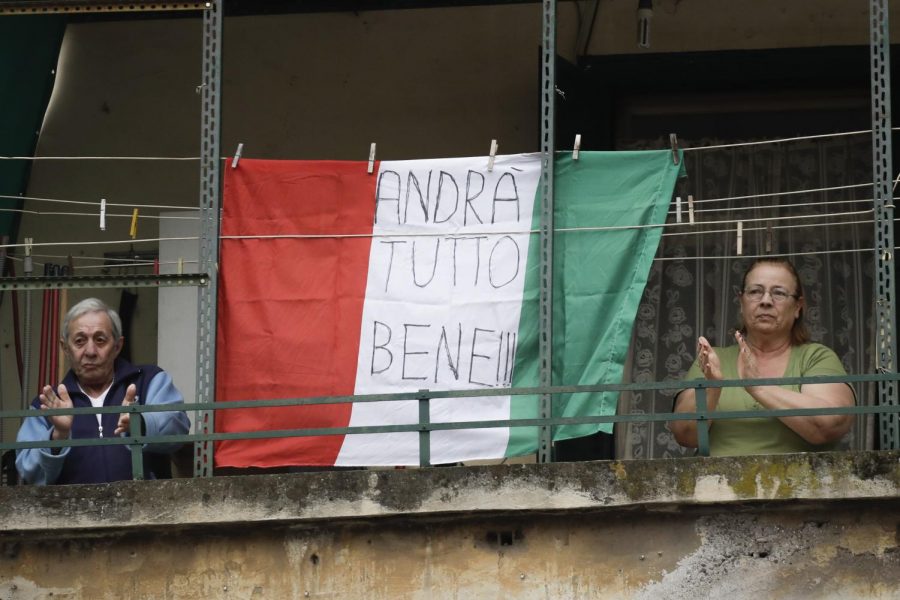Italy Lock down
March 20, 2020
On March 9, 2020, Foreign Affairs Minister Luigi Di Maio declared an official lock-down in Italy.
In this time of crisis with the Coronavirus or COVID-19, there have been 1,800 deaths, amid a total number of 25,000 cases and the numbers keep rising as the days go by.
According to BBC News, “Civil protection officials say 1,258 have recovered, although the number of cases has gone up by 2,651 since Wednesday. Italy is the world’s worst-hit country after China.” This was in the early dates of March.
in March, 10 northern cities like Milan, Venice, Genoa, Turin, Verona and Rome became red zoned. Italian citizens cannot leave their homes unless it is an emergency.
The movement has been limited to urgent medical or professional needs.
All the shops are now closed and Italy has become a ghost town in many cities. Only pharmacies and food stores remain open. Companies have been ordered to shut non-essential departments; a wide range of venues – from theaters to schools and hairdressers to museums – are closed.
Then on March 12, according to BBC News, Italian authorities stated the impact of the restriction could take two weeks to be seen nationwide and the virus, which is still surging in towns and cities outside the initial red zone, it is placing exceptional strain on Italy’s healthcare system – one of the best in Europe.
BBC News also reported that Di Maio stated, “If a doctor and a nurse can work for 24 hours non-stop, we can give up leaving our own home. The huge majority of citizens are respecting the rules. Those who aren’t will face sanctions: either fines or criminal charges.”
And to deal with the crisis the Italian government has placed Domenico Arcuri, as the new emergency commissioner.
Italy’s health care is urgently working with hospitals to resupply and get new equipment.
Di Maio also said, according to BBC News, “We need oxygen units, and we have started production with factories that produce them or others that can adapt to start producing them. We’re in contact with countries across the world, many of them are willing to supply us with equipment.”
The outbreak has made Italy suspend flights and tourists and Italian citizens are not allowed to fly out of the country. Extreme measures and precautions around the world have proceeded towards Italy, banned entry to Italians, and anyone who has traveled from Italy.
Countries like Austria and Slovenia placed strict restrictions on their borders with Italy.
My long term friends Tamara Piermartiti and daughter Tatiana Von Batzig, who live in the city of Palm Springs, left to Italy in June of 2019 for a vacation to visit their family. They always go to Italy every year for the summer, holidays, and stay for six-eight months.
Unfortunately with the outbreak of the corona-virus, their return to the states in February of 2020 was canceled.
The family has been quarantined for the past two months and hopefully, they will be able to return to America in April 2020, the month where the lock-down will hopefully be over.
Von Batzig said, “Italy was not equipped for this disaster a hundred percent. This is why we had so many cases of people diagnosed with the virus. It is becoming difficult to book a flight back to America. We want to leave in April but if we cannot, we will still be here. I am so sick of this.” I contact my friend every day and she’s scared, nervous, and trying her best to be calm about the situation.
While Piermartiti stated, “So far we are healthy, thank God. Only grocery stores, pharmacies, and banks are open. Our town is a ghost town, and everyone is staying in. It is truly strange to see our town like this. Hopefully, it will end soon.” The family is currently quarantined in Cupra Maritima, a small town in the central part of Italy.
“I have been wearing masks and being careful. Our media has updated us not to panic but know what is going on. They have been good at informing everyone and being optimistic. We will get through it,” said Von Batzig.
On the contrary, my friend Davide Di Carli, who is an Italian born citizen and business entrepreneur living in Rome said, “There’s a lot of cases in Italy and cannot work how I used too anymore. Now I have to work at home and people are crazy in the streets. There are long lines of people waiting to get food, fighting each other, even if the prime minister says not to worry and be optimistic, its a mess. Polices are everywhere and people cannot go out the streets unless it’s for work, buying food, or the hospital.”
Di Carli is stressed out, worried about his uncle who got sick and is trying to keep his mind steady.
Trying to make income now is a challenge.
Italy is creating a solution for those who are suffering from the virus and reassuring the public to not worry, their health care system has test kits ready to test people.
Von Batzig said, “The media is saying people are slowly starting to feel better as people are getting tested. Medicine is being created.”
World Health Organization’s COVID-19 test kits are in motion in countries like China and South Korea. South Korea has used test kits on 10,000 people a day and China will be sending a huge supply of necessary equipment to Italy.
The Italian media is informing the public there is a vaccine being created for the COVID-19. Whether this information is just a strategy to calm their people or if this is true, creating a vaccine does not happen overnight.
According to The Harvard Gazette for Health and Medicine, “it may be difficult to create hundreds of millions of doses, and each dose may be relatively expensive as it may require a fair amount of RNA. You can make more vaccine doses with DNA than with RNA, but it is unclear whether the production could be rapidly scaled to meet the massive international demand.”
Now with a national emergency announced in March 13 in the United States from President Donald Trump, we can just wonder how will the rest of the world be in this drastic year?










